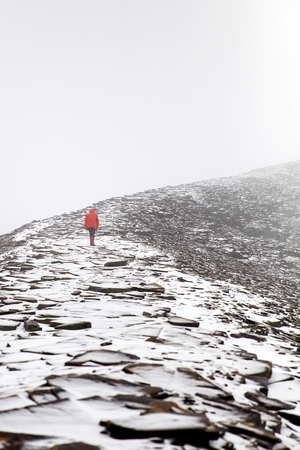Understanding British Hill Weather
There’s something quite special about the weather up on the classic British hills, and it’s not just the rain that gets everyone talking. The unique mix of rolling landscapes, cool air currents, and ever-changing skies means you’re likely to experience fog and mist more often than you might expect. These two weather phenomena are almost iconic features of hillwalking in Britain, making every outing a little adventure of its own. Fog tends to settle in when moist air cools rapidly as it rises over the hills, while mist is generally lighter but just as mysterious, blurring the edges of familiar paths. If you’ve ever set off on a clear morning only to find yourself enveloped in a silvery blanket before lunchtime, you’ll know how quickly conditions can change. Understanding these patterns is key for anyone looking to enjoy—and safely navigate—the beautiful, unpredictable British uplands.
2. What’s the Difference? Fog, Mist, and Low Cloud Explained
Anyone who has spent time walking in the British hills will know that the weather can change in a heartbeat. One of the most common sources of confusion is telling apart fog, mist, and low cloud—three conditions that can dramatically affect your visibility and enjoyment on the hill. Let’s clear up what each really means, with some practical examples from popular UK hill-walking spots.
Understanding the Terms
| Condition | Main Features | Typical Locations |
|---|---|---|
| Fog | Very dense; visibility less than 1 km (often under 200 metres); feels damp | Common at lower levels and valleys, especially early mornings in places like the Lake District or Scottish Glens |
| Mist | Lighter than fog; visibility between 1 km and 2 km; air feels moist but not as thick as fog | Frequently seen near rivers or lakes, such as around Ullswater or Loch Lomond, and sometimes on hill slopes during cool evenings |
| Low Cloud | Cloud base drops to ground level; can be patchy or persistent; visibility varies greatly | Common on high ground, such as the summits of Snowdon, Ben Nevis, or the Yorkshire Three Peaks; often called “being in the clag” by local walkers |
Spotting the Difference: Real-World Examples
If you’re hiking up Helvellyn and suddenly find yourself unable to see Striding Edge even though it’s only a stone’s throw away, that’s likely low cloud shrouding the summit. On a chilly morning walk along Hadrian’s Wall when everything around you seems blurred but you can still make out silhouettes in the distance—that’s probably mist. Meanwhile, if you’re wandering through a Cotswolds valley where even nearby trees look ghostly and indistinct, you’re deep in fog.
A Handy Rule of Thumb
The main difference between these three comes down to visibility distance and location:
- Fog: Most disruptive at lower levels—think driving or starting your walk in a car park.
- Mist: Less disruptive but still affects how well you can enjoy distant views.
- Low Cloud: Most common at hilltops—can turn navigation into a real challenge!
The Takeaway for Hill Walkers and Families
No matter which condition you face, understanding these differences will help you prepare properly—whether it means packing an extra map, keeping children close by in poor visibility, or simply knowing when to pause for safety. The next time someone asks whether you were caught in fog or just “in the clag,” you’ll know exactly what to say!

3. Staying Safe in Poor Visibility
If you’ve ever found yourself surrounded by thick British fog or low-lying mist while out on the hills, you’ll know how quickly the landscape can transform. When visibility drops, staying safe becomes a top priority—especially if you’re walking with children or less experienced family members. Here are some essential tips for managing risks and navigating confidently when the British weather throws its classic curveballs.
Navigation: Keep Your Bearings
Always carry a reliable map and compass, even if you think you know the route well. Modern GPS devices and smartphone apps are handy, but batteries can die or signals can falter in remote areas. Teach everyone in your group how to use basic navigation tools—especially older children—so you’re not solely reliant on one person’s knowledge. Stick to marked paths and avoid shortcuts, as it’s easy to become disoriented in poor visibility.
Group Safety: Stick Together
Poor visibility can make it surprisingly easy to lose sight of fellow walkers. Make a habit of regrouping regularly, especially at junctions or after negotiating tricky terrain. If youre walking with little ones, ensure an adult is always at the front and back of your party. Consider using brightly coloured clothing or simple hi-vis armbands so everyone remains visible in the murk.
Other Practical Tips
Before setting out, check the latest weather forecast and be prepared to adjust your plans if conditions look risky. Pack extra layers and waterproofs—even summer hill walks can turn chilly fast in the mist. Carry a whistle and torch for every group member; these traditional items are invaluable for signalling if you get separated. And finally, let someone at home know your planned route and expected return time—a small precaution that offers peace of mind for all.
4. Navigational Skills for the British Hills
The unpredictable weather on British hills means that strong navigational skills are absolutely essential, whether youre a seasoned local or a visiting family out for an adventure. When the fog rolls in or mist shrouds your path, knowing how to confidently use traditional navigation tools can make all the difference between a safe walk and a stressful ordeal.
Essential Navigation Tools
While GPS devices and mobile apps are handy, every hillwalker should be comfortable with the basics: map and compass. In low visibility, electronic devices can fail or lose signal, but a well-folded Ordnance Survey map and a reliable compass will never let you down. Make sure you’re familiar with grid references and contour lines so you can pinpoint your position even when the landscape around you disappears into the clouds.
Popular British Navigation Techniques
| Technique | Description |
|---|---|
| Handrail Navigation | Follow linear features like walls, streams, or paths that act as guides when visibility is poor. |
| Aiming Off | Intentionally aim slightly to one side of your target (like a junction or stream crossing) so you know which direction to turn when you hit it. |
| Pacing & Timing | Count steps or time your walk between landmarks to estimate distance travelled—very useful when you cant see far ahead. |
| Boxing Around Obstacles | If you encounter something impassable in fog, use your compass to make right-angled turns around it, keeping track of each leg to stay oriented. |
Family-Friendly Tip:
Involve children in simple navigation tasks like matching map symbols to features you do spot along the way; this keeps everyone engaged and builds confidence for future walks together.
Whether youre setting out for a short stroll or tackling a classic route in the Lake District or Scottish Highlands, practice these techniques before you need them. The more familiar you are with map and compass work, the more enjoyable—and safer—your day on the hills will be, no matter what the British weather throws at you.
5. What to Pack for a Foggy Hill Walk
If you’re heading out into the British hills, especially with family in tow, packing right is half the battle when it comes to dealing with fog, mist, and ever-changing visibility. Here’s a handy kit list designed with classic UK weather in mind—helping everyone stay safe, comfortable, and ready for whatever the countryside throws your way.
Essential Clothing
- Waterproof Jacket and Trousers: The British weather is famously unpredictable. A decent waterproof layer keeps both drizzle and dense mist at bay.
- Warm Layers: Fleece or wool jumpers are perfect—foggy conditions can feel chilly even in summer.
- Sturdy Walking Boots: Good grip is vital on damp or slippery paths hidden by low visibility.
- Gloves and Hat: Even in mild seasons, misty air can make it feel much colder than expected.
Navigation Tools
- Map and Compass: Sat-navs and phones are great but always carry a paper map and a reliable compass as backup—mist can play havoc with GPS signals.
- Whistle: For getting attention if anyone gets separated.
Visibility Aids
- Headtorch or Torch: Fog can make afternoons seem like dusk. A torch ensures you’re seen and can find your way.
- Hi-Vis Vests or Bright Clothing: Especially useful for little ones; bright colours help keep everyone visible in low cloud.
Sensible Extras
- Hot Drink Flask: Nothing beats a warm cuppa when you stop for a break surrounded by misty views!
- Snacks: Energy bars, fruit, or sandwiches keep spirits (and energy levels) up if the walk takes longer than planned.
- First Aid Kit: Always useful for bumps or scrapes on hidden rocks or uneven ground.
Packing Tips for Families
Packing together as a family not only makes sure no one forgets their gloves but helps little ones learn about safety too. Pop essentials into easy-to-reach pockets and share the load among rucksacks. And don’t forget—the best memories come from being well-prepared and able to laugh off the odd soggy sock!
6. Family-Friendly Hill Walking: Keeping Everyone Comfortable
Exploring the British hills in foggy or misty weather can be a magical experience for families, but it does require a bit of extra planning to keep everyone happy and safe. With a few simple preparations, you can turn what might seem like challenging conditions into an adventure that both children and adults will remember fondly.
Layer Up: Dressing for the Weather
British weather is famously changeable, especially on the hills. In fog or mist, dampness and chill can set in quickly, so make sure everyone is kitted out with waterproof jackets, warm layers, and sturdy footwear. Don’t forget hats and gloves, even in summer—foggy air can feel surprisingly cold! Pack spare socks and a dry top for little ones; there’s nothing worse than soggy clothes on a long walk.
Snack Stops: Keeping Energy High
Foggy days can sap your energy faster than you think. Bring along plenty of snacks—think oat bars, fruit, and chocolate treats—to keep spirits up. A flask of hot chocolate or tea is a real winner on chilly days and makes for a great morale booster during rest breaks. Remember to stop often to refuel and rehydrate, especially with young walkers in tow.
Making the Most of Local Points of Interest
Mist-shrouded hills are full of hidden gems waiting to be discovered. Break up your walk by planning stops at local landmarks—perhaps an old stone circle, a quirky trig point, or even a cosy café if you’re near a village. These mini destinations add excitement to the journey and give kids something to look forward to along the way.
Games and Stories: Adding Fun Along the Path
If visibility drops, use it as an opportunity to play games like “I Spy” (with sounds instead of sights!) or share local legends about the area. The atmosphere of low cloud makes stories feel all the more real—perfect for firing up imaginations and turning any walk into an adventure.
Safety First
Lastly, always make sure someone knows your planned route and expected return time before heading out in poor visibility. Bring a map, compass, and fully charged phone just in case. Stick together as a group—it’s easy to get separated in thick fog, especially with curious youngsters.
With thoughtful preparation and a spirit of adventure, walking Britain’s classic hills in misty conditions becomes not just manageable but truly memorable for families. Embrace the magic of the fog—you’ll soon have your own stories to tell!

